This is a submission for the Pulumi Deploy and Document Challenge: Get Creative with Pulumi and GitHub
What I Built
My project, Repo Blueprint CLI, is a command-line tool that automates the creation of GitHub repositories using predefined templates. It leverages Pulumi to provision repositories programmatically, making it easier for developers to set up new projects with consistent structures.
Key Features:
✅ Automated GitHub Repository Creation – Uses Pulumi to create repositories dynamically.
✅ Project Templates – Supports multiple templates like Node.js and Express.js for quick project setup.
✅ Pre-configured Files – Initializes repositories with essential files like index.js, package.json, and .gitignore.
✅ Infrastructure as Code (IaC) – Manages GitHub resources programmatically.
With Repo Blueprint CLI, developers can streamline the process of setting up new repositories, reducing manual work and ensuring best practices. 🚀
Live Demo Link
Project Repo
My Journey
Project Development Process
- Initial Planning & Setup The project started with the goal of automating GitHub repository creation using a CLI tool built with Pulumi. The key steps involved were:
Setting up the project structure with Node.js and Pulumi.
Configuring GitHub authentication via a personal access token.
Defining project templates (e.g., Node.js, Express.js) for repository initialization.
- Implementation Developed a CLI command (create.js) to automate repository creation.
Used Pulumi's GitHub provider to provision repositories programmatically.
Implemented template handling to initialize repositories with relevant files.
- Challenges & How They Were Overcome a) Pulumi Configuration Issues Challenge: Encountered errors related to Pulumi.yaml configuration and stack outputs.
Solution: Verified stack settings, ensured github:token was correctly set with pulumi config set, and reviewed Pulumi's documentation.
b) Missing Dependencies
Challenge: Errors like "Cannot find module '@pulumi/github'" and "Cannot find module 'dotenv'".
Solution: Installed missing dependencies using npm install and updated the package.json to include all required modules.
c) Pulumi Output Handling
Challenge: Error messages stating "Calling [toString] on an [Output] is not supported."
Solution: Used apply() or pulumi.interpolate instead of .toString() when handling Pulumi outputs.
d) Repository Push Blocked (Secrets Detected)
Challenge: GitHub rejected pushes due to detected secrets in .env files.
Solution:
Removed sensitive data from commits.
Updated .gitignore to exclude .env files.
Used git rebase -i HEAD~X to remove commits containing secrets.
- Key Learnings Pulumi Best Practices: Learned how to properly configure and use Pulumi’s GitHub provider.
GitHub Security Rules: Understood GitHub's secret scanning and how to prevent push protection errors.
Modular Code Design: Improved handling of dynamic template creation using JavaScript functions.
Debugging & Dependency Management: Learned how to efficiently debug module resolution errors and manage dependencies in Node.js projects.
- Next Steps Expand the CLI to support more templates.
Improve error handling and user feedback.
Automate repository setup with initial commits and CI/CD integration.
Using Pulumi with GitHub
Pulumi was the core infrastructure-as-code (IaC) tool used to automate GitHub repository creation. Instead of manually setting up repositories, Pulumi allowed us to define repositories as code, ensuring consistency, repeatability, and automation.
Implementation Details
GitHub Provider: We leveraged Pulumi's GitHub provider to programmatically create repositories.
Automated Setup:
Created repositories with predefined templates (e.g., Node.js, Express.js).
Configured repository settings such as visibility and default branches.
Added template files like index.js, package.json, and .gitignore.
Secrets Management: Used pulumi config set github:token --secret to securely store GitHub credentials.
Benefits of Using Pulumi
✅ Infrastructure as Code (IaC): Defined repositories in a structured, version-controlled manner.
✅ Automation: Eliminated manual GitHub setup, reducing errors and improving efficiency.
✅ Security: Handled sensitive credentials securely using Pulumi’s built-in secret management.
✅ Scalability: Made it easy to create multiple repositories with consistent settings.
Pulumi Copilot Usage & Key Prompts
Pulumi Copilot was used to generate configurations and troubleshoot issues. Some key prompts included:
"How do I create a GitHub repository using Pulumi?"
"How do I securely store GitHub tokens in Pulumi?"
"How do I apply Pulumi Outputs correctly to retrieve repository URLs?"
"How can I initialize a repository with template files using Pulumi?"
Challenges & Solutions
Issue: "Calling [toString] on an [Output] is not supported."
Fix: Used apply() and pulumi.interpolate for handling outputs properly.
Issue: "Push declined due to repository rule violations (secrets detected).”
Fix: Removed secrets from committed files and used .gitignore to prevent future issues.
Future Enhancements
Automate repository initialization with default commits.
Integrate CI/CD workflows using Pulumi.
Extend support for more project templates.

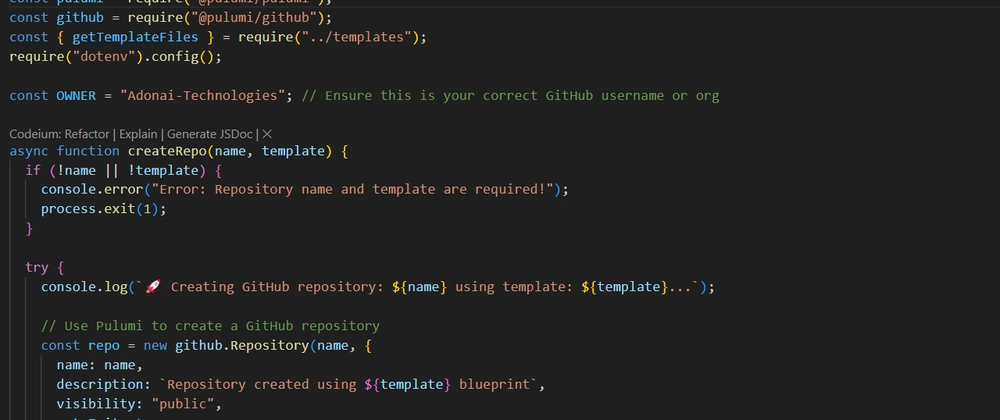
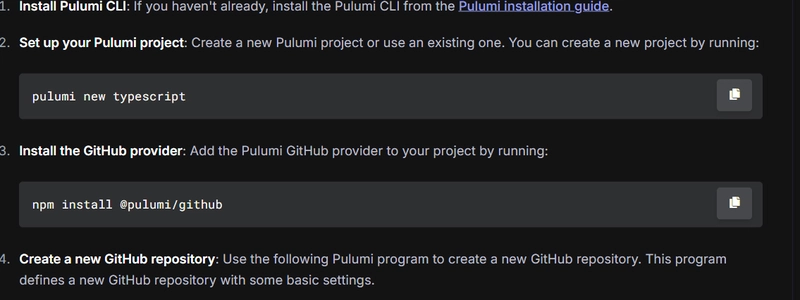

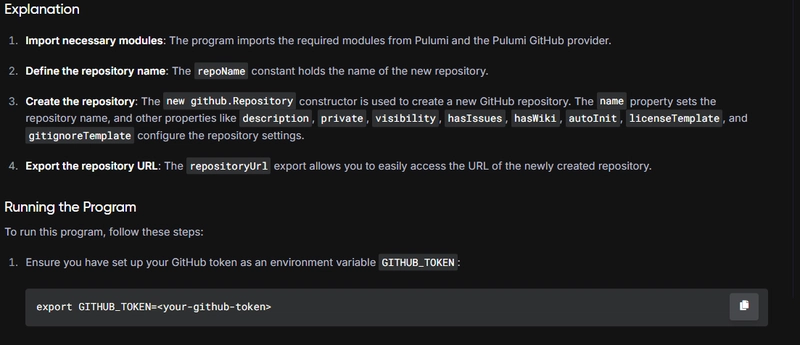


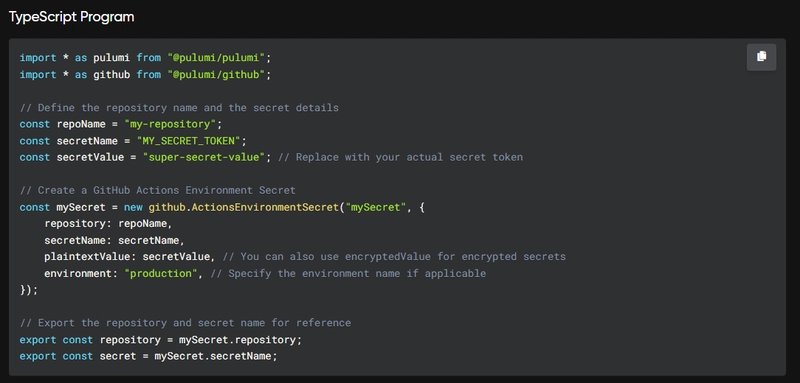

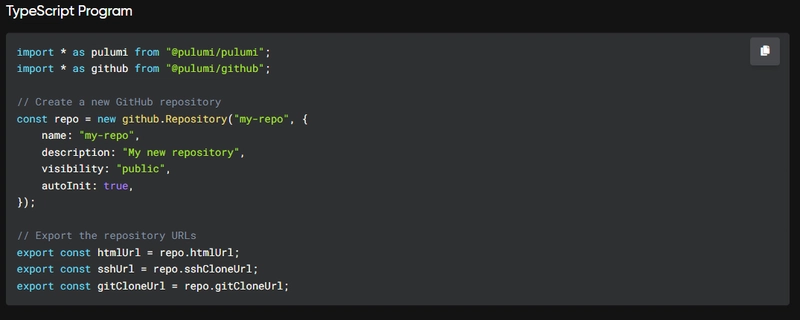
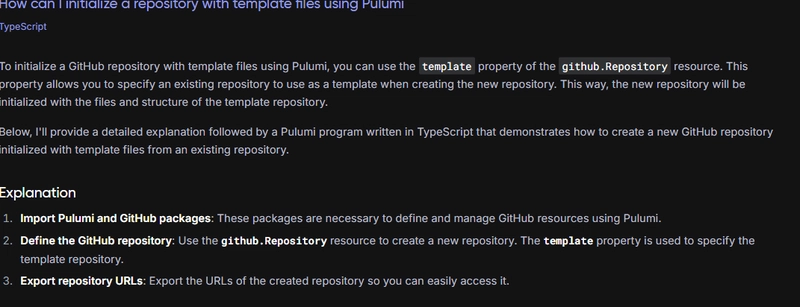

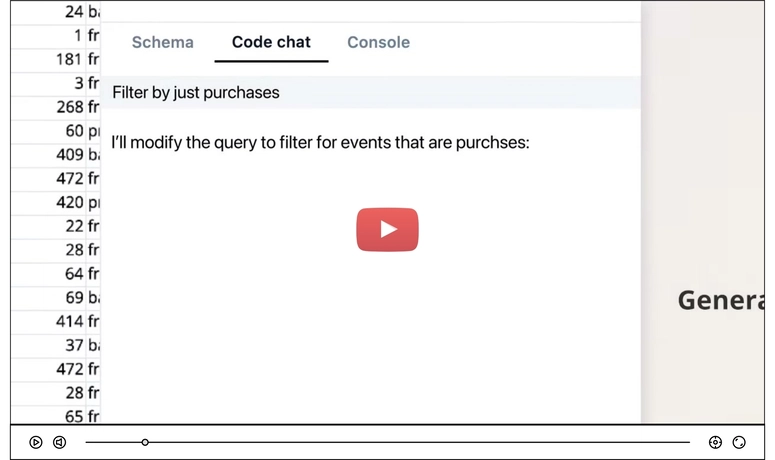

Top comments (0)